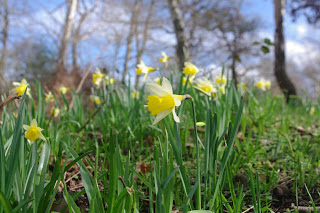A diary of back garden botany, urban ecology, rural rambles and field trips to the middle of nowhere...
Friday, 28 September 2018
A calendar of wildflowers: as summer turns to autumn the wildflower season draws to a close. I thought I'd trawl through the archives for a compilation of some of our common and uncommon wildflowers through the year.
Snowdrops (Galanthus nivalis) are one of the first to show their heads in late winter from February onward into March.
Primroses (Primula vulgaris) are prolific in early spring in both town and country. Wild Daffodils (Narcissus pseudonarcissus) are abundant in some parts of the country though absent in others. Cowslips (Primula veris) can form large colonies in grasslands and pastures that have not been lost to modern farming methods.
Some wildflowers have particularly specific habitats and often these are the very habitats that have been diminished over decades.
Pasque Flowers (Pulsatilla vulgaris) occur in a handful of places around Eastertime in England on sloping unploughed chalk and limestone grassland.
Snake's-head Fritillaries (Fritillaria meleagris) require meadows that flood in winter to flourish whereas Summer Snowflakes sometimes called Loddon Lillies (Leujocum aestivum) require permanently marshy habitats on the margins of rivers. The river Loddon is indeed its most substantial location though curiously it isn't present in similar conditions elsewhere.
Spring is the season for woodland wildflowers like Wood Anemones (Anemone nemerosa), Bluebells (Hyacinthoides non-scripta) and Ramsons (Allium ursinum). They like the shade of deciduous woodland but take advantage of the extra light to flower before the leaves fill out the canopy.
So too the flowers of the hedgerow come forth in spring like Greater Stichwort (Stellaria holostea) and Hedge Woundwort (Stachys sylvatica).
Orchids are in a class of their own. There are orchids that flower early, orchids that flower late, some in the shade, some in the sun. Some like it dry, some like it marshy. Certain plants are generalists but orchids are highly specialised in their adaptations to very specific niches.
I think the ones above are pink and white forms of the Common Spotted Orchid (Dactylorhiza fuchsii) which aren't very common anymore. Indeed many of the 56 varieties of orchid that grow in the UK are rarities and some are on the verge of extinction.
Many wildflowers favour open ground. In fact Foxgloves (Digitalis purpurea) also do fine in semi-shady woodland glades and hedgebanks but Meadow Cransebill (Geranium pratense) likes plenty of mid-summer sun.
Meadowsweet (Filipendula ulmaria) and Purple Loosestrife (Lythrum salicaria) are also sun lovers but need plenty of moisture. The former is a plant of marshy meadows, the latter of riverbanks and ditches.
In the lazy, hazy daze of high summer Field Scabious (Knautia arvensis), Ox-eye Daises (Leucnathemum vulgare) and Knapweeds (Centaurea species) illuminate traditionally farmed meadows and other grasslands.
As summer progresses peak flowering starts to wane but coastal wildlflowers persist. Viper's Bugloss (Echium vulgare) grows near the coast. Sea Lavender (Limonium vulgare) carpets muddy salt marshes and Sea Mayweed (Tripleurospermum inodorum) grows among the shingle of stony beaches.
By the end of September most plants that are native or naturalised in the UK have flowered but their foliage may remain as a reminder of their presence. Or in some cases their seed heads may be just as striking as their flowers like these Teasels (Dipascus fullonum).
























